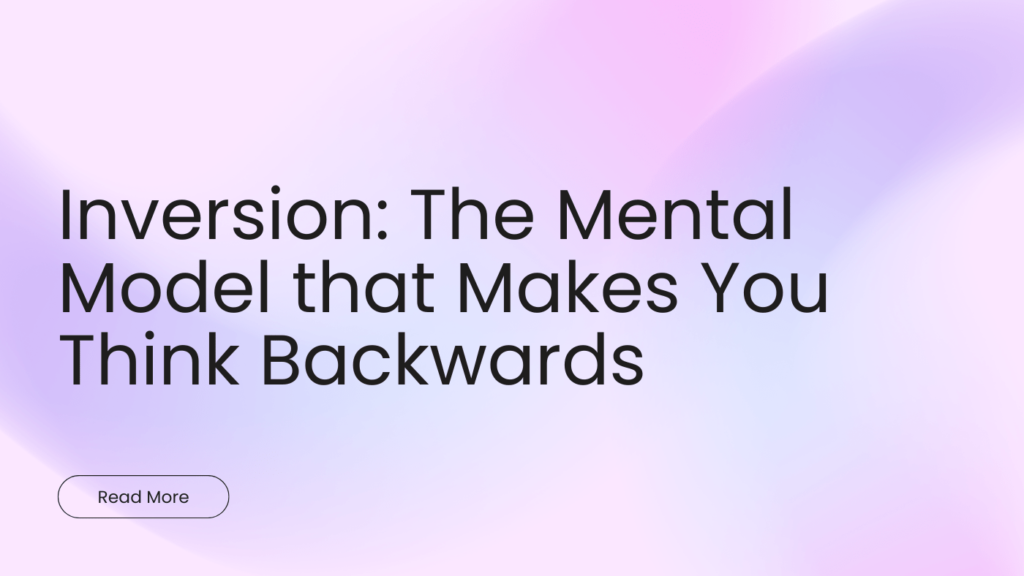Inversion: The Mental Model That Makes You Think Backwards
In a world obsessed with forward progress and proactive solutions, the inversion mental model offers a refreshing, and often more effective, alternative: thinking backwards. This powerful cognitive tool encourages us to identify potential problems by considering how we might cause them, a surprisingly effective method for creative problem solving with inversion.
What is the Inversion Mental Model?
At its core, inversion is about flipping a problem on its head. Instead of asking “How do I achieve X?”, you ask “How could I fail to achieve X?”. By exploring the paths to failure, you often uncover critical obstacles and assumptions that you might have otherwise overlooked. Charlie Munger, Warren Buffett’s longtime business partner and a staunch advocate for mental models, emphasizes the importance of inversion in decision-making. He famously said, “All I want to know is where I’m going to die, so I never go there.” This embodies the essence of thinking backwards to avoid undesirable outcomes.
As detailed in the book “Poor Charlie’s Almanack: The Wit and Wisdom of Charles T. Munger,” inversion is not just a clever trick; it’s a rigorous method for identifying and mitigating risks.
Why Use Inversion?
There are several compelling reasons to incorporate the inversion mental model into your problem-solving toolkit:
- Uncovers Hidden Assumptions: By considering how to fail, you force yourself to examine the underlying assumptions that are necessary for success.
- Identifies Potential Roadblocks: Inversion helps you foresee potential pitfalls and obstacles that might not be immediately apparent.
- Generates Creative Solutions: Often, the process of identifying ways to fail leads to unexpected insights and innovative solutions.
- Reduces Bias: Thinking about failure can help to counteract optimism bias, which can cloud judgment and lead to poor decisions.
- Simplicity: Sometimes, solving problems directly can be complex and overwhelming. Inverting the problem can simplify the process by highlighting obvious negative constraints.
How to Apply the Inversion Mental Model
Applying inversion is relatively straightforward, but it requires a conscious effort to shift your perspective. Here’s a step-by-step guide:
- Clearly Define Your Goal: Start by clearly stating the outcome you desire to achieve. For example, “Increase website traffic by 20%.”
- Invert the Goal: Transform your goal into its opposite. In our example, this becomes “Decrease website traffic by 20% (or more).”
- Brainstorm Ways to Fail: List all the possible actions or inactions that could lead to failure. This is where you get creative. Some examples for our inverted goal might include:
- Stop publishing new content.
- Remove existing high-performing content.
- Ignore SEO best practices.
- Neglect website security, leading to hacking and downtime.
- Engage in black hat SEO techniques that get the site penalized.
- Identify Key Obstacles: Review your list and identify the most significant obstacles to your original goal. These are the factors you need to actively avoid or mitigate.
- Develop Countermeasures: For each key obstacle, develop strategies to prevent it from occurring. This is where you formulate your action plan for achieving your original goal.
Examples of Inversion in Action
The inversion mental model can be applied to a wide range of situations:
- Business Strategy: Instead of asking “How can we increase profits?”, ask “How could we bankrupt our company?”. This might lead you to identify unsustainable cost-cutting measures or risky investments.
- Personal Finance: Rather than focusing solely on how to get rich, consider how you could lose all your money. This could highlight the importance of diversification and responsible spending habits.
- Project Management: Before starting a project, brainstorm ways it could fail. This allows you to proactively address potential risks and challenges.
- Relationship Building: Instead of thinking about how to improve a relationship, think about how to ruin it. This might reveal behaviors that you need to avoid.
For example, in his book “The 7 Habits of Highly Effective People,” Stephen Covey encourages readers to “begin with the end in mind.” This is a form of inversion, as it involves envisioning the desired outcome and then working backward to determine the necessary steps.
Creative Problem Solving with Inversion: A Deeper Dive
Creative problem solving with inversion isn’t just about avoiding negative outcomes; it’s about unlocking new perspectives and generating innovative solutions. By forcing yourself to think in reverse, you break free from conventional patterns of thought and open yourself up to possibilities you might have otherwise missed.
Consider the problem of traffic congestion. Instead of solely focusing on building more roads, you might invert the problem and ask, “How can we maximize traffic congestion?” This could lead you to consider solutions such as:
- Encouraging single-occupancy vehicles.
- Eliminating public transportation options.
- Creating unpredictable traffic patterns.
By identifying these factors, you can then work backward to develop strategies that alleviate congestion, such as promoting carpooling, investing in public transport, and implementing intelligent traffic management systems.
The Limitations of Inversion
While inversion is a powerful tool, it’s not a silver bullet. It’s important to acknowledge its limitations:
- Requires Cognitive Effort: Thinking in reverse can be mentally challenging and requires a conscious effort to overcome ingrained thought patterns.
- May Not Always Be Applicable: In some situations, the inverted problem may not be meaningful or relevant.
- Potential for Negativity Bias: Focusing too much on failure can lead to excessive pessimism and paralysis by analysis. It’s important to balance inversion with a healthy dose of optimism and action.
Conclusion: Embrace the Power of Thinking Backwards
The inversion mental model is a valuable tool for anyone seeking to improve their decision-making skills and solve problems more effectively. By learning to think backwards, you can uncover hidden assumptions, identify potential roadblocks, and generate creative problem solving with inversion . Incorporate this powerful technique into your repertoire, and you’ll be well-equipped to navigate the complexities of life and achieve your goals. Start questioning your path forward by considering how it can all go wrong, and you’ll find yourself on a far more secure and successful route.
“`


